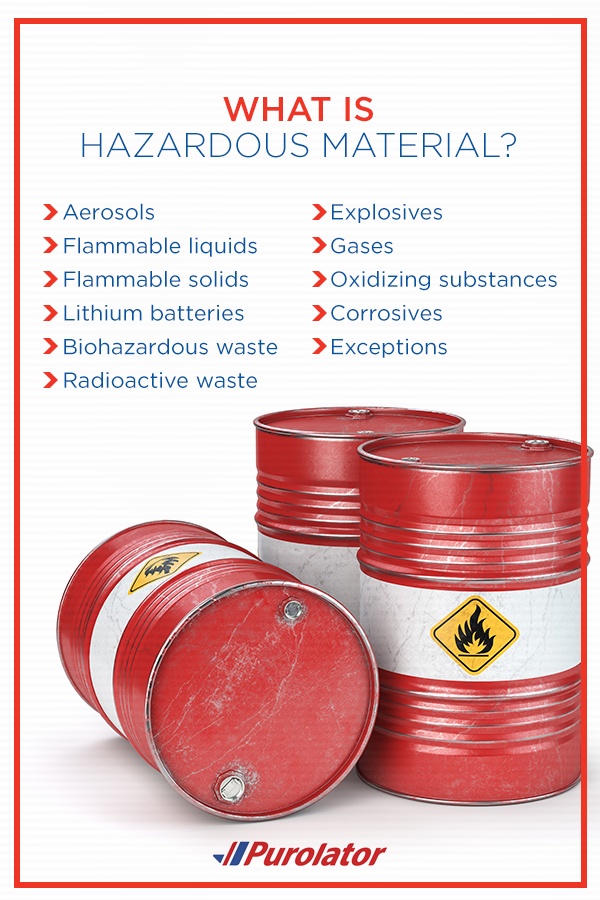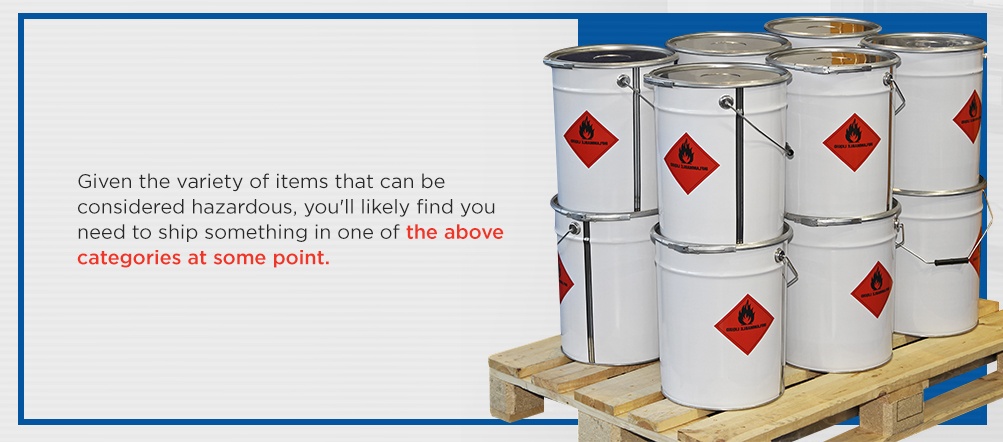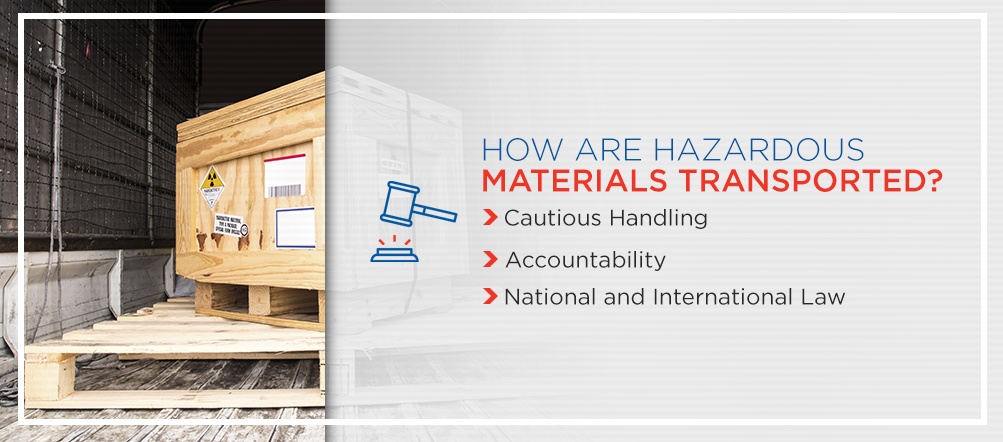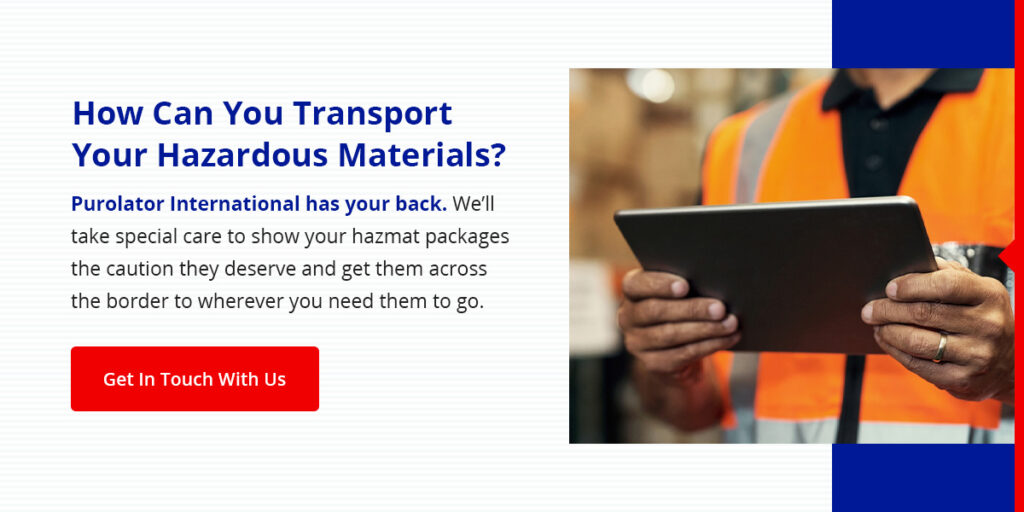Blog
A Guide to Shipping Dangerous Products
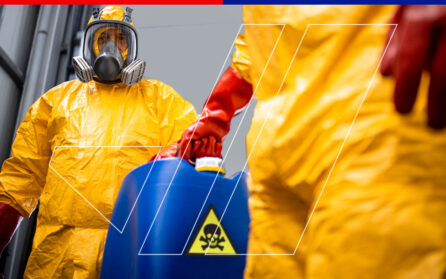
Whatever industry you work in, there’s a good chance you’ll find yourself shipping something that qualifies as a hazardous material. Many products contain elements that could pose a danger if mistreated, and such products are legally required to be shipped a certain way.
But how do you know if these requirements apply to you? What sorts of things qualify as hazardous materials? And if you find yourself needing to ship any, how do you go about packaging and transporting them? In this safety guide to hazardous logistics, we provide the answers to those questions along with some tips for shipping dangerous goods.
What Is Hazardous Material?
Hazardous materials — or “hazmat,” for short — are any items that, when shipped, could cause any sort of danger to the other products or people involved in the shipping process. Some materials quite obviously fit into this category, such as toxic chemicals and explosives.
But even if your products seem benign, they may still qualify as hazardous, depending on the ingredients they contain. While you can find many ways of classifying hazardous materials using various levels of detail, here’s an overview of some of the most prominent types that tend to be shipped.
- Aerosols: Aerosols are substances enclosed under high pressure and released as a spray. These are usually contained in cans and sold as consumer products. Examples are cooking spray and various types of hair spray. They pose a danger due both to the pressure inside the container, which poses a risk of explosion, and to the flammable nature of some aerosol substances.
- Flammable liquids: Flammable liquids are liquids capable of quickly, easily and often spontaneously catching on fire. These can appear in the form of consumer products, as well as industrial ones. Examples are paint, gasoline, oil and certain perfumes. They pose a danger due to the potential of them being ignited in transit and causing harm to people, vehicles and products.
- Flammable solids: Flammable solids are, like flammable liquids, materials capable of quickly igniting, but in a different state of matter. As with flammable liquids, solids may be marketed to consumers or industry professionals, depending on the form they take. Examples are matches and certain processed metals. They, too, pose the danger of igniting in transit.
- Lithium batteries: Lithium batteries come in two forms — lithium metal, which tend to be non-rechargeable, and lithium ion, which are rechargeable. These usually appear in the form of consumer products. Sometimes, these batteries are marketed and shipped on their own, usually in bulk. However, they can also appear in electronic products, with common examples being computers and phones. They pose the risk of igniting and burning through their containers.
- Biohazardous waste: Biohazardous waste is any sort of biological substance that could contain infections or pathogens. Usually, it’s not intended to be sold as a product, but is either being disposed of or taken to a lab for analysis. It could appear in the form of medical waste, such as blood. It’s dangerous because of its capability to infect people or objects coming into contact with it.
- Radioactive waste: Radioactive waste is any substance that emits potentially harmful radiation. As with biohazards, it doesn’t tend to be a product. Instead, it often results from nuclear medicine and nuclear research and is usually being transported to a place it can be disposed of. It presents the danger of emitting enough harmful radiation to function as a carcinogen.
- Explosives: Explosives are, as the name implies, materials designed to create an explosion. Mild forms of this type of material can manifest in consumer products, while more powerful explosives are used in industries like military or construction. Examples are industrial gun cartridges, black powder and dynamite.
- Gases: Any gas capable of acting as a poison, explosive or other cause of harm may be considered hazardous. Gases can appear in both consumer products and industrial tools. While things like aerosols can sometimes be included in this category, another example would be dry ice. Some gases are most harmful if inhaled, while others are capable of igniting.
- Oxidizing substances: Oxidizing substances are any materials that are capable of oxidizing other materials, often causing them to combust. This property makes them especially dangerous when paired with other hazardous materials that are already at risk of combustion. Typically, they’re being transported for use in labs, as opposed to being consumer products. They usually appear in the form of raw chemicals, such as bromine or chlorine.
- Corrosives: Corrosives are substances that are capable of corroding, burning or dissolving materials they contact. Some will dissolve skin, while others are even capable of burning through metal, which means they must be kept in highly specialized containers. Like oxidizing substances, they usually appear in raw chemical form, such as hydrochloric acid, and are therefore industry products rather than being for consumers.
- Exceptions: All of these items, along with other miscellaneous things, compose the bulk of the hazardous materials subject to legal regulations in both the United States and Canada. But not everything that could fit into those categories necessarily will. Certain types of perfume, for instance, are deemed harmless enough not to be subject to hazmat transportation regulations. It all depends on the exact nature of the substance, so be sure to check the regulations themselves to determine whether any of your materials are considered hazardous.
How Should You Package Hazardous Materials?
Given the variety of items that can be considered hazardous, you’ll likely find you need to ship something in one of the above categories at some point. Even if it’s not as overtly dangerous as an explosive, it could still be something like perfume or matches.
When that happens, what should you do? How should you go about packaging it? Here are some of the basic things to know about how to ship dangerous products.
1. Pack Securely
A good place to start is to pack all your materials as securely as you can. By doing what you can to keep them locked down safely, you minimize the risk of anything bad happening. In the case of aerosol cans, for example, you should keep the caps on, and then wrap them in bubble wrap or another such material to keep them from rolling around.
Take similar approaches with other hazardous materials, storing them securely with plenty of padding, so they experience as little jostling and nudging as possible while in transit. Also, take care not to pack incompatible items together, like explosives and oxidizing substances.
In extreme cases, as with nuclear or radioactive waste, the materials will have to be stored in a special type of container designed for that substance, like the yellow drums familiar from the imagery of various films. Hopefully, most of your materials will be more ordinary and can be packaged in standard boxes and containers. But they’ll still need to be secure, so make sure they are!
2. Label Containers
Once you’ve packed the materials into containers, make sure you label those containers appropriately. You’ll want to do whatever you can to help make supply chain workers aware of their contents. Use appropriate hazmat stickers on the outside of the container. Try to minimize the number of labels there, however, so as not to distract anyone with an overabundance of information.
As well as marking what the materials are and the dangers they pose, mark how they should be handled. Ensure the shipper is aware of how to treat them, both through actions like marking “this side up” on the container and through communicating directly with the shipper.
3. Document Everything
In a similar vein, document everything about the process. Keep records of everything you’re shipping, for both yourself and the shippers. Document the materials being shipped as well as the way they’re packaged and labeled. The more information you keep track of, the easier it will be for you to handle anything that might go wrong down the road. Some documentation may be legally required anyway, but even if it’s not, you’ll still want to record everything that goes on in the process.
4. Track Your Package
It’s also imperative to track the materials you’re shipping. At the very least, take advantage of tracking labels so you can follow the progress of your materials as they make stops and stay up to date on where they are. Better yet, you can use a GPS tracker, which will allow you to see the location of your package at any given moment. Tracking your package helps keep you informed and prepared in case something goes wrong along the way.
5. Obey the Law
Of course, while it’s a good idea to do all these things anyway for the sake of safety, in many cases it’s required by law — especially if your package is being transported by plane. Some materials can’t even be legally shipped by plane to start with. For those you can ship, there may still be several procedures you have to follow.
The exact nature of what you have to do will vary based on the type of material, whether it’s new or reused, and whether or not you’re shipping it in bulk. Different combinations of those factors will lead to different requirements. In some instances, you may have to use United Nations specification packaging, which will have to undergo tests with the materials inside to ensure that it works before it’s allowed to be shipped.
How Are Hazardous Materials Transported?
Once a package has shipped, the shipper will have their own set of responsibilities to adhere to. Based on the information you provide, they’ll need to make sure they take all the necessary precautions when handling the package. These precautions involve everything from direct handling methods to adherence to federal law, often in more than one country. Here are some of the main things shippers are responsible for when transporting hazmat.
Cautious Handling
As previously noted, most of the shipper’s job regarding dangerous items — similar to your own — comes down to taking precautions. Some of these precautions simply have to do with being careful when picking up or moving the package, but others are more specific to the materials involved.
Individual drivers and loaders will have to pay careful attention to all the labeling on the container, noting the specific hazards and any special procedures for moving it. Some will need more care than others, and that care could manifest in different ways. It’s not a good idea to drop aerosol, for instance, especially at high altitudes.
Accountability
The shipper must hold its workers accountable during the transit process, checking in on the state of the package as it moves. It can also help the workers by providing them with checklists for dealing with the package, describing the things they need to do when handling it and the order in which to do them.
Sometimes multiple hazardous packages will be shipped together, and one must always be kept away from another, requiring them to be loaded and unloaded a certain way. Workers must make sure they adhere to these requirements.
National and International Law
When hazmat crosses international borders, such as between the United States and Canada, even more requirements must be met. Canadian law generally permits incoming shipments that meet the requirements of United States federal regulations, but exceptions exist for circumstances where American and Canadian hazmat laws differ.
Furthermore, that allowance only applies to vehicles that entered Canada from the United States. If a vehicle stops in Canada and transfers the package to another vehicle, the new vehicle must fully satisfy Canadian legal requirements. This law primarily affects the placards used on the outside of the vehicle to indicate that it’s carrying hazardous materials — the American placard can stay on the vehicle that originally carried hazardous materials, but any later vehicles must use Canadian placards.
Additionally, Canadian law may require an emergency response assistance plan (ERAP) for certain materials. An ERAP is a system set up between shippers and emergency personnel before shipping, where the emergency personnel are notified of the hazardous materials and provided with the necessary equipment to combat it in the event of an incident. Shippers may also be required to provide a training certificate for the workers involved in the shipping process.
All of these regulations necessitate the use of a shipper with the right degree of qualification and competency to transport hazmat across international lines.
The Challenges and Risks Involved in Shipping Dangerous Products
Handling hazmat is complicated, and every shipper and logistician would do well to remember it. Failing to follow industry and legal guidance can result in more than hefty fines — in extreme cases, it can also lead to tragedy.
We don’t mention these risks to scare you, though — we just want to make sure you know what to expect. Here’s what every shipper should keep in mind when transporting and handling dangerous goods.
Challenges of Shipping Hazardous Materials
For many shippers, one of the most difficult challenges in shipping hazmat is adhering to the various regulations in place for their industry, state or region. Keeping track of all the laws that can apply can be difficult, especially in international shipping, and breaking these laws often comes with serious consequences.
Some of the biggest regulatory obstacles logisticians face include:
- Certification: In many jurisdictions, dangerous goods handlers must receive proper certification from an accredited body — depending on the specific credentials they possess, they may have to undergo recertification on an annual or biennial basis.
- Documentation: Shippers must retain a copy — physical or digital — of all papers associated with dangerous goods shipments for a specified period of time.
- Classification: Each country has its own system for classifying dangerous goods, which can make international shipping unnecessarily complicated. While these guidelines are not binding, the United Nations’ Recommendations on the Transport of Dangerous Goods defines nine universal hazmat classifications you can use as a starting point.
- Transportation mode: Each different type of transportation follows different rules due to each method’s unique limitations. For example, air transport is by far the most regulated means for transporting dangerous goods, and ground shipping is typically the least.
Deciding on the most appropriate method of transportation, obtaining the proper licensure and ensuring your goods are correctly classified can be challenging, but working with a trustworthy third-party logistics provider is an excellent way to manage your hazardous materials shipments.
Deciding on the most appropriate method of transportation, obtaining the proper licensure and ensuring your goods are correctly classified can be challenging, but working with a trustworthy third-party logistics provider is an excellent way to manage your hazardous materials shipments.
Safety Concerns for Employees and the Environment
Dangerous goods are called “dangerous” for a reason — unless properly handled, they can cause serious harm to human and environmental health. Some of the biggest concerns in hazmat transportation include:
- Personal injury: Hazmat can be explosive, poisonous, corrosive, or even all of the above — mishandling these goods puts every person who comes into contact with them at risk of physical harm.
- Damage to property: Mishandling products can lead to breakage or spoiling, resulting in lost revenue for the producer.
- Public endangerment: If released near a populated area, mishandled hazmat can put citizens in harm’s way.
- Environmental damage: Mishandling a biohazard or flammable object can cause serious harm to the environment — for example, accidentally dropping an explosive could spark a major wildfire.
- Potential reputational damage: If your company is caught mishandling dangerous goods, customers are less likely to put their trust in you, leading to lost business and decreased revenue.
- Civil penalties: Failure to comply with dangerous goods regulations can lead to expensive fines and, in particularly severe cases, potential litigation.
- Potential suspension of licensure: Individual handlers — or your company as a whole — may completely lose their ability to handle dangerous goods following an incident.
The best way to prevent these consequences is to do thorough research before you need to ship anything. Consider who you can trust to handle your goods properly, and take the time to familiarize yourself with all your available options.
How Can You Transport Your Hazardous Materials?
Once you know what materials are considered hazardous, how to package and document them, and how they need to be shipped, you still have one decision left — who will ship your package? You need to be sure your shipper can safely transport dangerous material, and if your company doesn’t have its own shipping service, it can be difficult to determine whom you should entrust with the task.
Fortunately, Purolator International has your back. We offer on-time service to 220 countries, with particular expertise in shipping across the U.S.-Canadian border. We’ll take special care to show your hazmat packages the caution they deserve and get them across the border to wherever you need them to go. Just get in touch with us to get your package — hazardous or not — shipped today!
